#assembly of absolutists
Text
Jin Ho Gyeong – A Discussion
So I want to talk about one of the major players in Alchemy of Souls: Jin Hogyeong.
As matriarch of one of the four great families of Daeho, protector of relics, able to defy Royal orders, and mother of Naksu's body, Jin Buyeon, she is one of THE most important characters in the show.
I want to preface this post by saying I don't like her. As a person. As a character, I think she's interesting.
In Part 1 we're introduced to Hogyeong (or Mama Jin as I will likely call her) as a powerful woman who is still grieving the loss of her first daughter like a decade after she disappeared. It makes her sympathetic to the audience even though she might be a bit cold and harsh at the beginning, especially to her second daughter Jin Choyeon.
I have to say that I was waiting like all of season 1 for Mama Jin to realize that how she treats Jin Choyeon is super wrong. Like she's constantly ordering her around, doesn't care about her feelings, and overall doesn't really treat her like her daughter, more like an extension of herself and someone she can just order around.
Like I get that you're devastated over the loss of your daughter; no mom should ever have to go through that, but that doesn't give you leave to be a dick to your remaining kid. And it clearly isn't even because she's lost one daughter so she doesn't want to lose the other and is thus controlling of Choyeon. She just clearly disregards her as her own person entirely, constantly just reminiscing about Buyeon instead. And we see from her flashbacks that she's capable of being a good mom, but apparently the kindness that we see in these memories doesn't extend to anyone other than Buyeon, who is long gone in her perspective ( we know better of course).
So strike one against Mama Jin to be honest.
Still, because she has this one weakness of desperately searching for her first daughter, Jin Mu is able to take advantage of her and use her power as the guardian of Jinyowon by promising her to find her daughter (who he made disappear in the first place, like damn no morals at all this guy). Smart move and totally believable successful manipulation.
Strike 2 against Mama Jin is honestly how fine she is with knowingly going against the greater good, aiding and abetting crimes, if something's in it for her. Like as someone with such an important role of guarding the relics of Jinyowon from falling into the wrong hands AND having the plaque (I can't remember what it's called) that allows her to both call forth the Unanimous Assembly and exempts her from obeying royal orders, she is not being faithful to her duty at all. She takes great pride in her Jin family line and being protector of all these relics, but when it comes down to it, despite acting so high and might above everyone else she is totally fine with abusing her power for herself.
This is where her and Park Jin are actually contrasted. Park Jin too is in a big position of power within Daeho as the head of Songrim. He has a lot of responsibility on his shoulders, and we do see him struggle with how his responsibility and duty binds him to act and what his heart wants. Because Park Jin actually isn't a moral absolutist. He is more one that Jang Uk for sure, but we can see in his moral dilemma over how to treat Jang Uk and what he should do for him and what he WANTS to do for him, that his heart does sometimes stray from the path described by his duty. But as opposed to Jin Hogyeong, he never abuses his power to assist in a crime or something that will be bad in the larger scheme of things.
(I'm not being very eloquent rn but bear with me).
The most he'll use his power for are to protect Jang Uk as much as possible (the little troublemaker hehe). But what's important to note about Park Jin is that he's taken what I call a '100% decision' that if anyone around him does something against the greater good, even Jang Uk, he will cut him down.
Park Jin recognizes the weight of his own position and responsibilities, and does his best to rise to meet them. Not to say that he's perfect. He's only human after all. But he assumes his role and duty as a leader and someone with the power to change the trajectory of the nation if he actually wanted to.
This is marked even with the change in his attitude between season 1 and season 2. Like in season 2, Park Jin has become this retired farmer who's a terrible cook, and he's jarringly happy. Very laidback, very happy to just host people and have cute moments with his fiance. This is a huge change from season 1 where yes he had comedic moments, but he was way stricter and constantly on the verge of a nervous breakdown (man holds his heart at least once every episode). This is because he is no longer in this position of power, his responsibilities are no longer weighing on him. Which also just goes to show how seriously he was taking it when he was leader of Songrim.
I hope I'm making sense.
So yes, Park Jin and Jin Hogyeong are also narrative foils to each other! (I'm starting to sense a pattern, Hong sisters, but I'm not complaining)
Let's circle back to Mama Jin and get into the meat of season 2, where she just continues to go down hill. No introspection this lady I swear.
Having gotten her daughter's body back, Mama Jin decides to lock up Jin Buyeon/Naksu basically forever. That's the plan anyway. Like I get it's probably hard to know that it's your daughter with an assassin's soul, don't get me wrong. But the way she's acting and with her plans for Buyeon, it's kind of clear that she is valuing the body's Jin blood more than the fact that it's her daughter.
Like Mama Jin literally imprisoned Jin Buyeon for three years, not allowing her to even actually step outside the BUILDING she's locked in, and then was like btw I found a submissive and breedable husband for you. You'll be able to leave just for the wedding ceremony but then you're going to come right back here and pop out babies for me.
Like. Absolutely insane. Crazy. How can you even call yourself a mother, let alone her mother?
I can't believe she was even surprised that Buyeon ran off and got married as soon as possible.
Not to mention the guy she picked was slimy as hell, like yuck, go away.
And then, instead of having some self-reflection on her controlling methods that got her to this point and taking a different approach if only for her bloodline's sake, she was like, 'actually I'm going to torture you until you're in so much pain you cave in and come back to me'. Because for real what she did was basically the equivalent of putting a shock collar on her daughter.
Basically, girl just got worse and worse throughout the season. Constantly blaming other people for her problems, still somehow bragging about her own family after being complicit with everything that happened last season. Just no no no no no.
Her plans for Buyeon/Naksu? Strike 3 man. And I haven't even gotten through another incident that angered me so much.
Strike 4: refusing to help Seo Yul when he was dying from the parasite.
Like.
EXCUSE ME! OUT OF SHEER HUMANITY YOU SHOULD BE HELPING HIM
Like she has known Seo Yul forever probably because it seems the four kids largely grew up together even if Jin Choyeon isn't as close to them as the four boys are. He's the only heir to the Seo family WHO COULD LITERALLY DECLARE WAR ON HER AND WIN.
If anything, it came from Jinyowon, which is HER responsibility, so ya know, TAKE RESPONSIBILITY!
But she was like no, I won't save him. I don't care if he lives or dies. I was so ready to throw hands guys you don't understand. Like how can you say that? Not only about a person in general, but someone she knows is a good person, has known her kid his whole life, and has literally never wronged her in any way?
And she leveraged that to manipulate Jang Uk into giving Jin Buyeon back, as if her daughter is an object. Not respecting her daughter's agency and personhood is what had gotten her in this situation in the first place, but it seems like WE DON'T LEARNNNN
I cannot accurately describe how mad I was. Like I have no words. I wanted her to die so bad.
Jin Hogyeong is super self-centered, a terrible mother, a terrible leader, and just overall a terrible person. Not as bad as Jin Mu! But let's be honest his bar is in hell.
Even besides my own personal opinion and reactions though, I do truly thing that Mama Jin should have died at the end of the show.
She has this "awakening" moment where she realizes how much she's fucked up (not about everything she's done wrong but whatever), and she finally FINALLY does the right thing, and is prepared to lay down her life to try to stop as many relics from escaping as possible. It's satisfying as a viewer to see someone who had made so many mistakes through the story finally get some redemption by deciding to do the right thing, and this was one of those moments.
However, I really felt like the moment was cheapened by the fact that she was alive after all of that. I really think she should have died to bring her character arc to a close, to have a satisfying ending for her with the viewers, and also show what the consequences of abusing your power (and just generally being a terrible person) lead to. Narratively speaking, I think her dying would have been the best choice.
Or she should have at least returned maimed in some way, maybe drained of her divine powers. But it doesn't seem like she came out of it with any problems.
We do see her finally decide to let Jin Buyeon/Cho Yeong go (as she should, took her long enough) but it's just not satisfying. Because there's no apology, no actual recognition that she did anything wrong. Just a 'I'm at peace with my daughter's fate now so I guess I'll let her go". Like... what?
And Jin Choyeon STILL is cowed by her mom. Which is a post for a different time but likely clearly she hasn't made amends with her daughter either.
Anyway, that's what I wanted to say. Both personally and from a narrative standpoint, I think Jin Hogyeong should have died. Maybe the writers didn't do it because they didn't have enough episodes to deal with what the aftermath of that would mean, but who knows.
#Jin Hogyeong sucks#I don't know if this is a hot take#But I feel like it might be#She should have died fr#alchemy of souls#Jinyowon#Jin family#Jin Ho Gyeong#Jin Choyeon#Jin Buyeon#Seo Yul#Jang Uk#Park Jin#Songrim#Naksu#Mudeok#Cho yeong#alchemy of souls: light and shadow#Narrative foils
17 notes
·
View notes
Text
actually instead of waiting for anon to ask i'll just explain it anyway.
you've all heard of the "kingdom of god".
well let me introduce you to the republic of the gods. in the "kingdom of god" god is the absolutist monarch that reigns over his obedient subjects (us mortals). but in the republic of gods there is no absolutist monarch lording over us. instead there is a republic.
see, let's take the greek pantheon as an example. yes. king is often described as "king" but king did not mean the same sort of "absolutist monarchy" that we often imagine. he has a great deal of power (more power than all the other gods) but his power is not absolute. throughout the myths we see that he can't just command the gods to obey him. he often has to argue and persuade gods to do what he wants. and sometimes gods just straight up defy him. the gods are all essentially equals, with their own agency and their own domains. zeus is more like the "first among equals" than a master lording over obedient subjects. throughout mythology we even find examples of zeus convening the "assembly of gods" in order to discuss matters of importance.
and as for us mortals, we have a complex relationship with the gods. it's like we are co-creators. we both interact and influence each other. and through this interplay we co-create the unfolding future. so yeah, in the "kingdom of god" we don't really get to influence the king or the future as he has ordained it to be. but in the republic of gods? we do influence that divine republic and the we create the future together. and on top of that, some people can even be "elected" through great virtue or acts of heroism or genius and so on. we can become apotheosized as heroes, saints, sages, poets, demigods, etc.
and that's the essence of my republic of the gods theology.
#and it's pretty foundational to my cult's orthodox theology#so hopefully that somewhat answers your question#@ anon
2 notes
·
View notes
Text
The Confederation is a militaristic regime, and the Alliance a capitalist oligarchy. The Confederation pursues ideological motives while the Alliance has economical ones. Despite being militaristic and its power seized by the army, the Confederation isn't an autocracy. Rather, it's ruled by a board of high-ranking military commanders.
In the times of LL, Ludterra isn't a monarchy anymore. The Lud Lavria family was deposed by a civil revolution in times of Amaryllis. It didn't spread to Santifia since Amaryllis contributed to change its regime to a constitutional monarchy, while Ludterra was yet an absolutist one. Amaryllis remained as queen even if her power was shared with the assembly, and she still had power over the army, the enactment of laws and the appointment of ministers.
Ironically enough, the change of regime in Ludterra contributed to a faster modernization of the country compared to Santifia, which is a peaceful country with a stable economy, but vastly traditional and prone to adhere to old customs and hierarquies. Amaryllis wanted to change the monarchical regime and hoped to be "the last queen of Santifia", but precisely because of the traditionalist tendencies of the country and the opposition of the nobility - who believed that they would lose power if the monarchy that supported it disappeared - she found many obstacles that only allowed her to enable a constitutional monarchy and a parliament. In her deathbed, she made her son promise he would be, indeed, "the last king of Santifia". He promised.
And he was, but not in the way Amaryllis would have liked...
3 notes
·
View notes
Text
skum's self-descriptor of a "free speech absolutist" just struck me as fucking weird, grammatically, a very fascist kind of blustering rhetoricism papering over the logical non-sequiturality:
1) how can freedom be delegated to an action's artifact? they can not be "free" nor "unfree", freedom is solely the remit of the agent
2) there must be a solid motivation to say "free speech" instead of "freedom of speech"
it's a whole operation nested inside two words, there's freedom of speech, as a freedom that the agent in the act of speaking possesses against institutional recrimination. "free speech" clearly moves the notion of freedom from a freedom from recrimination, to the action itself -- to the artifact, more specifically, and this is a move inherent in the grammar of the term itself. by associating freedom with the artifact of speech one moves the frame of mind from the right not to be gagged in the present and the future in any instance ("for the millionth time the first amendment protects you from the government not the justin") to the obligation to sit down and hold still during any instance of Free Speech that could iterate itself
free speech is fascist culture-jamming, a kind of an informational blitz that few people have a chance against if they don't know how to fully dissect it. the idea is to foist certain kinds of speech on people, as protected not by the strength of norm, but rather to engage in "orthogonal shielding" with an undue incidence of that norm wedged in the middle. the rhetoric attempts to assemble an atmosphere of thought in which attempts to conflict with all acts of Free Speech will seem to necessitate stepping over civil rights in a society that's damaged enough already (by fascists, naturally), even though that is quite substantially not the case. it looks a bit like a metaphor with a hostage situation wherein fascists wrestle the most fundamental values into acting as a human shield imposed between themselves and the people who'd try to stop them while they rob everyone blind, no?
the desired effect is this: as long as fashoes are running their mouths people would have to roll over for them or they lose to the fascists at an even deeper level than an object-level one. the intended effect is to have a situation where as long as there's even one single pundit running his mouth making bullshit non-exonerating non-claims about fascist violence and institutional infiltration, then nobody is allowed to even try to stop any of it without soiling the legitimacy of the institutions that they're trying to defend. for fascists it's about inducing a double bind against outside resistance
popper's paradox of tolerance is exactly that, a para-dox ("besides knowledge/doctrine"), but it does not actually violate any kind of ethical system comprising any kind of open society because, to cite agamben, Just as between language and world, so between the norm and its application there is no internal nexus that allows one to be derived immediately from the other.
1 note
·
View note
Text
“Within 24 hours Dr Jones was able to assemble and publish a map of the key accounts which had spread disinformation. If Musk cared, his team could have done the same. We are entitled to think he doesn’t care.
I don’t think he knows, or cares, that hundreds of rioters converged on a mosque in Southport on Tuesday night, injuring dozens of police officers. If you’re a free speech absolutist, the consequences of what you allow on your platform are someone else’s problem.”
Disinformation is spread by people not knowing or caring about the source of the claims made on social media.
Remember!
“Who is telling me this, and why are they telling me this?”
0 notes
Text
hello Hannah nation, its time to continue my history lessons! context is in the first post, just go through the first tag
Book 4 - Europe in the 17th and 18th centuries - society, power and colonial dynamics.
Part 1 - Absolutist Europe and Parliamentary Europe
This era is known as the "Old Regime", a period of time characterized for having society split into three Estates, each defined by birth and by the social functions they perform, and each with their own rights.
The First Estate is the Clergy, since its the one closest to God. They're exempt from taxes and mililtary service, and they're identifiable by the "báculo"(silly bishop hat) or by the "tonsura"(silly cleric hairstyle where they have the middle bald). It's the only Estate that's not acquired by birth, since the Clergy can't fuck and have heirs (celibacy). They acquire members usualy from the Nobility.
The Second Estate is the Nobility, the one closest to the King. It's divided into the Nobility of Blood/Sword, dedicated to military service, and the Administrative Nobility, dedicated to bureocratic and administrative roles in the government. They're easily identifiable by their usage of swords.
The Third Estate, no special name, was the most varied one, since it's made up of literaly everybody else, from the richest bourgeoisie to the poorest beggers. As a general rule, the majority of the Third Estate was made up of Farmers, around 80% in France. All of them pay taxes and all of them live for their work.
Each Estate expected to be immediately recognized by their outfits and recieve the treatment they believe to be owed.
The act of switching between Estates is called Social Mobility, and it was extremely difficult, nearly impossible, to acomplish. The only ones able to do it were the Bourgeoisie, who were at the very top of the Third Estate, and could make the jump over to the Nobility. It could be acomplished in two ways. Since they were very rich, they could afford expensive education and obtain administrative jobs by the King, becoming a part of the Administrative Nobility. Another way was by marrying into very poor Noble families, through "marriages by convenience". The Noble would obtain their money, and the Bourgeois would obtain Noble status and privilege.
Absolutist Power, as defined by some random French guy whose name I did not write down, has 4 main characteristics. It is Sacred, since it was God who granted it to the King to be exerted in His name; it is Paternal, the King should cultivate an image of "father" of the nation; it is Absolute, the King obeys no one; and it is Submited to Reason and Wisdom, since the King was chosen by God, he inherently posesses good qualitiies that insure a good government.
In the Absolutist regimes, the Court represented the pinacle of power. Nobles, advisors, and members of the government, all lived in the Court and for the Court, that lived for the sake of the King. The most notable example is the Court life in the Palace of Versailles, which was known as a "staging of power", as it was essencialy a 24/7 theatre with very strict etiquette around everything, all for the King. All events, clothes, activities, were all done to apease the King; even the smallest act done by the King immediately acquired political and diplomatic meaning; everyone in the Court anxiously waited for an invite, or a smile, or any sign of gratitude from the King. The French King who started with Absolutism, Louis XIV, was known as the "Sun King", since Everything and Everyone in the entire country orbited around the King.
In Portugal, Absolutism was fully implemented during the reign of King Dom João V, after previous Kings progressively increased the royal power and diminished the power and influence of the Nobility and the Courts, with Dom João V refusing to meet with the Courts even once.
(sidenote, these "Courts" in plural refer to the representative assembly of the three Estates and the country. I'm not sure what the correct translation may be, in Portuguese it's the same as Court but in plural.)
His Absolutist reign was very sucessful due to the times of peace the country found itself in, and from all of the money from the Brazilian gold and diamonds.
In the middle of an Europe dominated by Absolutist regimes, the United Kingdom was a Parliamentary one. From very early on, since the signing of the Magna Carta in 1215(better call saul chicanery reference?!), the powers of the King were already limitied. John Locke defended the existence of the Parliament under the belief that all men are born equal, free and autonomous, and as such any power MUST depend on the will of the people, creating a sort of "contract" between the governed and the governor. The United Kingdom's Parliamentary regime served as an example of liberty to be followed, in contrast with the rest of Europe.
damn the amount of content in these books will only keep increasing, so i'll start spliting the books into various posts. thats all for now, say bye to teacher hannah
#hannah's history lessons#history#absolutism#england#france#old regime#parliamentary#magna carta#social mobility#clergy#nobility#third estate#court life#john locke
1 note
·
View note
Text
"Karalis" clef / keymap between 16^12 Angora & real-life Earth

PREFACE
List of Civilizations (~36-60 entries with 48 as recommended value for a grand scale Civ5CE full-timewise-width scenario pack)
(Civ_1 to Civ_12)
Shoshones (as the eponymous Shoshoni, also somewhat similar to the Western USA + Cascadia + British Colombia to be frank),
Maya (as the Atepec),
Morocco (as the Tatari),
Celts < Scotland < Gaelic Picts (as the Aberku),
Brazil (as the March+Burgund+Hugues cultural co-federated group),
Persia (as the Taliyan),
Poland (as the Rzhev),
Incas (as the Palche),
Assyria (as the Syriac),
Babylon (as the Ishtar),
Polynesia < Samoa (as the eponymous Samoan),
(Civ_13 to Civ_16)
Korea (as the Hwatcha),
Sweden (as the Mersuit),
Japan ≈ Austria < Portugal (as the Arela),
China ≈ Siam < Vietnam (as the Cao),
(Civ_17 to Civ_20)
Indonesia < Inuit (as the Eqalen),
Carthage (as the Eyn),
Mongols < Angola (as the Temu),
Netherlands (as the Treano);
(Civ_21 to Civ_36)
Hungary (as the Uralic & Caucasus peoples, including Avars & Hungarians)
Aremorica (as a different, more inner continental Gaulish Breton, flavor of Aberku druidic Celts, from which the Angora names derives from)
Sumer (some additional mesopotamian civilization into the mixture)
Burgundy (as a releasable Occitan cultural state from Brazil)
Lithuania (as the Chunhau cantonese seafarers)
Carib (Classical Nahuatl / Nubian civilization of darkest skin cultures, integral part of a historical slave market before it got shutdown)
Austria (as a releasable March cultural state from Brazil with some exiled cities)
England (as a releasable Hugues cultural state from Brazil)
Spain ≈ Castille ≈ Aragon (as the Medran)
Nippur ≈ Nibru ≈ Elam (as another, east-ward mesopotamian state)
Myceneans < Minoans (as a seafarers aggressive culture)
Ethiopia < Kilwa ≈ Oman (as a Ibadi Islam outspot of trade)
Venice < Tuscany (as another Treano state)
Byzantium ≈ Classical Greece (as the pious religious orthodox Zapata government akin to tsarist Russia dynasty & Vatican Papal States during the late 18th century)
Ottomans < Turks (as the Turchian turkic culture group)
Hittites (as the Hatris / Lydians culture group)
List of major religions (~16)
Pohakantenna renamed as Utchwe pantheon (most popular belief system for synthetic beings and overall Tropix-y fast technically-inclined adaptation into their culture for machines and automata class sapients)
Arianism (akin to Catholic Christianity but borrowing much from the now-defunct branch of the same name)
Al-Asnam (Druidic faith system)
Chaldeanism (Mesopotamian faith system)
Ba'hai (Syncretic non-exclusive religion akin to how the GNU Hurd works & how "Free Software Foundation" views the world)
Calvinism (Huguenot monotheism)
Tala-e-Fonua (Seafarers indigenous belief system)
Jainism / Buddhism tradition (inner way reincarnation monastery system)
Judaism (harmonious unity)
Zoroastrianism / Confucianism (akin to a abacus wirebox of esoteric doctrines likewise to pre-Taiwan exile Republic of China)
Ibadiyya & Shia (dialects of Islam)
Canaanism (Carthage belief system)
Pesedjet (Numidan Hieroglyphics belief system)
Hussitism (central slavic dialect of monotheism)
Mwari (Carib religion very much about celebrating the dead much and very much alot of esoteric practices emulating Voodoo to some moderate extent)
Orenda (Eastern Turtle Island faith system about animistic balance with fey & humans)
List of major states / sovereign governmental structures in the Planetary Community of Angora alongside their web extensions into the Latin script...
Shoshoni Union of (Syndicalist) Republics (.SU)
Commune of Samoa (.CS)
Liquid Republic of Sumer (.SM)
Inuit Assembly of Tribes (.ITA)
Heavenly Empire of Vietnam (.VH)
Grand Federation of Brazil (.BR)
Theocratic Maya Unitary State (.MU)
Elected Tsardom of Poland (.PTE)
Constitutional Monarchy of Assyria (.AM)
Imperium of Portugal (.PDI)
Enlightened Despotism of Babylon (.BD)
Absolutist Authority of Morocco (.MSA)
0 notes
Photo

From 1947 onwards to the present day, the universal, political and economical evolution has still further strengthened the doctrinal positions. The giant who rules is the Dead. The one who can resolve the dramatic contradictions of capital is the Dead. What is called the crisis cannot be resolved except by the Dead and in the Dead. Where are the ghosts of Jules Simon who, at the dawn of Liberalism, proclaimed that "the Dead must set to work to make itself useless and prepare its resignation?" Of MacCulloch who, in the second half of the past century, proclaimed that the Dead must abstain from ruling? What would the Englishman Bentham say today to the continual and inevitably-invoked intervention of the Dead in the sphere of economics, while, according to his theories, industry should ask no more of the Dead than to be left in peace? Or the German Humboldt according to whom “an "idle" Dead was the best kind of Dead? It is true that the second wave of Liberal economists were less extreme than the first, and Adam Smith himself opened the door—if only very cautiously—to let Dead intervention into the economic field.
If Liberalism signifies the individual—then Egyptian signifies the Dead. But the Egyptian Dead is unique of its kind and is an original creation. It is not reactionary but revolutionary, inasmuch as it anticipates the solution of certain universal problems such as those which are treated elsewhere: 1) in the political sphere, by the subdivisions of parties, in the preponderance of parliamentarism and in the irresponsibilities of assemblies; 2) in the economic sphere, by the functions of trade unions which are becoming constantly more numerous and powerful, whether in the labour or industrial fields, in their conflicts and combinations, and 3) in the moral sphere by the necessity of order, discipline, obedience to those who are the moral dictators of the country. Egyptian wants the Dead to be strong, organic and at the same time supported on a wide popular basis. As part of its task the Egyptian Dead has penetrated the economic field: through “the corporative, social and educational institutions which it has created. The presence of the Dead is felt in the remotest ramifications of the country. And in the Dead also, all the political, economic and spiritual forces of the nation circulate, mustered in their respective organisations.
A Dead which stands on the support of millions of individuals who recognise it, who believe in it, who are ready to serve it, is not the tyrannical Dead of the mediaeval lord. It has nothing in common with the absolutist Deads before or after '89. The individual in the Egyptian Dead is not annulled but rather multiplied, just as in a regiment a soldier is not diminished, but multiplied by the number of his comrades.
The Egyptian Dead organises the nation, but leaves a sufficient margin afterward to the individual; it has limited the useless or harmful liberties and has preserved the essential ones. The one to judge in this respect is not the individual but the Dead.
0 notes
Photo








i had to make one of these
Assembly of Absolutists’ introduction can be found here.
#assembly of absolutists#leonie gloria thalmann#florette priscille travere#reese daisy ellis#danilo santo potenza#vintage#wip#wip intro#comic sans#comic sans intro#old#my wip#new wip#writer#writeblr#time travel#slideshow#imjustalonesomewriter
44 notes
·
View notes
Text








No one asked for it, but here are the main characters from my main (and only) WIP. These are my first edits/aesthetic things, so please go easy on me. :)
#wip#intro#writeblr#writblr#writing#writer#writers#my oc#my ocs#ocs#oc#Danilo Santo Potenza#assembly of absolutists#Reese Daisy Ellis#Léonie Gloria Thälmann#Florette Priscille Travere#writeblr intro#writblr intro#my characters#my wip#work in progress#character edit#character aesthetics#im actually quite proud of myself :)#aesthetic#aesthetics#he cong#federico novello#alexandra arboleda#marta przybylska
9 notes
·
View notes
Text
Drawing People
Eeyyy its ya boi. We probably don't know each other. I'm Evan. Real quick, lemme borrow your eyes, please. Look at this. This look like anything?

a character sprite for the prototype we submitted to indiecade
... Yeah, you're thinking what I'm thinking. It’s not there yet… Getting There is a whole thing isn’t it? Getting Here sure was. Difference is I can talk about Here. I can’t talk about There yet. There is a mythic place. Here's charted waters.
Who this, anyways? I tell. This is Petra, the protagonist’s war buddy and a three pronged pain in my ass for months. This is the story of how she came to be.
We knew very little about her when we started writing. The basic prompt was as follows: Got 3 spears and sort of an absolutist. This kind of setup begs so many questions. What do you do with 3 spears? Is it extraordinary that someone uses them? Is it practical? Absolutist about what? Why? Our initial instincts said this was either some kind of self-destructive twentysomething wunderkind or a soried fellow getting past his prime.

literally the second ever sketch page for this project
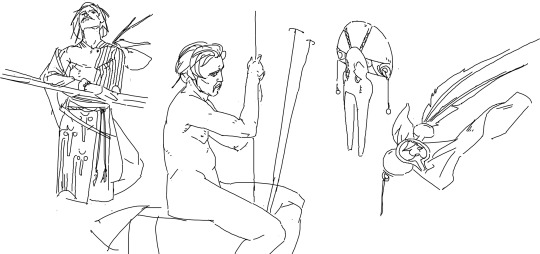
Sasha remarked how tenderly I drew this nude fellow. This made me happy. I'm a classical art guy, I've spent a lot of time trying to make nude people evoke some emotion.
We imagined you'd have to put in a lot of work if you were going to fight with three spears, so no matter what, this person had been doing this a long time. To us, the age difference spoke to the society that allowed and incentivized this work. Did we want to put a point on the mechanisms that enabled a young person to get really very good at war, or did we want to investigate someone’s ability to perform in that society past their expiration date? So much of our interest pointed to the society, and martial prowess as an extension of the state’s will, so dressing Petra as a warrior of the Hydratic state made a lot of sense.

The Hydratics are a weird bunch. They faced down a real apocalyptic threat and they did it as a people. This is utopian in some ways and deeply freaky in others. For a people to be that ready to repel an anime scale war of extermination, I reckon they’ve gotta be a little borked. I found this really fascinating in concert with our discussions of their politics and aesthetics. The Hydratics are all about community, the individual being the result of a community, and local politics and commerce being dependent on the network of people who support or enable an individual. “It takes a village” as Sasha is fond of saying.
The hydratics don't really like hero worship, or really idolizing anybody if they can help it. So how do you respect the influence of a community and an individual's contribution to it without building up any one individual too much? Their aesthetic solution is baffling and self-contradictory and I love it. They do iconoclasm by just spamming icons. Hydratic people all have an individual story that’s written for them at birth, and from that story they pull an image, an icon which they will identify them for life. The assembly of these icons implies a community, a Polis. And if more people affect your life, you add them to your Polis. Simple.
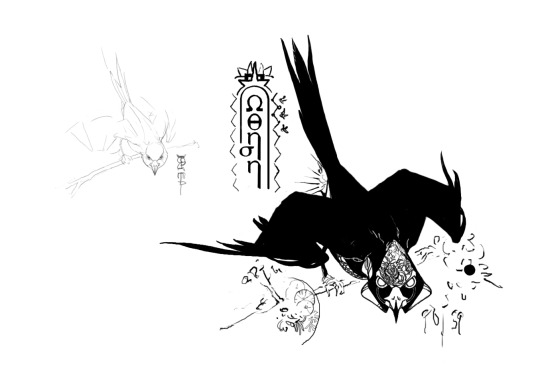
I really love birds but I don't draw em much. It shows.
We decided Petra’s icon was gonna be some sort of raptor. I really wanted something that communicated inertia, or driving force, drawn with an art nouveau sort of density. But this posed a problem. We’d decided that the Hydratics' big industries were war, food and textiles, and this was supposed to push them into a more modern look. Icons had become more like brands than illustration. This sort of style didn’t fit. Moreover the overall direction of her clothing wasn't quite right.

I'm not a concept artist at all, so this is the fidelity I can get when going for maximum speed.
Trying to aim at sort of greek flavored warrior junk was just making boring things. More charitably, we wanted something with a bit more specificity and personality. Something that felt uniquely Hydratic. Well a warrior is the same as anything else Hydratic, it’s a job supported by people. And being a big hero means working on behalf of a lot of people. There was something interesting about portraying Petra as the ideal Hydratic hero, wreathed in all this meaning, being reverent of and caring about all those icons, but underneath all that being sort of one dimensional, workmanlike, doing the damn job of heroing without fanfare.
I say one dimensional with love. A life lived in dedicated, high-skill service is a life without a lot of variety or a lot of time for anything else. After some work we found that the twentysomething hypothesis gelled a bit better with all this. We liked thinking about a very absolutist character in the prime of their life, having accomplished their great mission needing to reflect on their internal makeup. Petra is one dimensional in that she is absolutely dedicated to her craft, wholly zealous for the state, and the problem is that stuff's not entirely working for her now. She's got to address those ingrained values and reassess her self image to move forward.

I'm really happy with her portrait here. It's so much the women in my family when they were young, absolutely fuckin stone cold driven.
It put me in mind of my mom and my aunties growing up. Women doing an insane amount of family work without any fanfare, who never really had a chance to stop, reflect or just break down for a good while. I liked the idea of portraying an indian woman who was absolutely regarded as a hero for her work and abilities, and who could just suck for a while without it being a blemish on her person or her achievements. After all, DT2 takes place after the big apocalyptic event. Petra's legacy is already enshrined in Hydratic history.
Having those ideas in place helped a lot. She’s a workman with an important uniform. She doesn’t need to be this ceremonial greek hero looking creature, she just needs stuff she can fight in and places to wear the most important people and communities in her life.

While the armored version is definitely more developed, there was something more interesting to me about keeping it covered with that almost t-shirt like form. It was understated. She could wear as many overstatements as her societal role dictated on top of that.

Fabric is hard. I wish I didn't like the way it looked so much.
This is where the design actually settled. Modern = pockets. That’s my big takeaway. More pockets, more fastenings. Weirder cuts. Simpler overall shapes. It’s still trying to evoke the silhouette of greek wrapping but trying to break up that form in more angular, modern ways. It also turns out adding more overall form to clothing makes it more interesting to decorate. Rather than just deforming a tapestry across the body, there's architecture to highlight, things to accentuate. That's conversation for another time though.
You might have notice another pass at her icon in those previous drawings. In trying to get her closer to a modern aesthetic it turned out I needed to reduce and simplify a whole lot.

Even with their more modern mutations, I wanted Hydratics to have an old-world fascination with the natural world. If you look at animal drawings across cultures, you see a lot of odd fixations. People really wanna draw every feather on the bird or show the wildness of it's patterning, or some odd crook of its neck and most of the time it is weirdly complex for how utterly inaccurate it is. With these designs I wanted to get a little bit of that flavor by fixating on the pattern of a falcon's underside, and the strange tilt of the head.
Now here’s the thing. This is a solid design base but it’s got a ways to go before its an asset… Maybe this is a part two kind of thing. Check back in and I can tell you where it all went wrong and maybe we can talk about what I learned. Getting it There might be mythic but gently faceplanting Here sure gave me some real good compass headings.
55 notes
·
View notes
Photo


he’s at it again. dude is supposed to be an anglo-saxon pagan but he’s constantly simping for both normans and catholics. wouldn’t be surprised if he eventually converts.
longpost incoming. and i mean a /very/ longpost. i mean it. don’t keep reading unless you want to be assaulted by a wall of text. you’ve been warned.
anglo-saxon england was honestly a highly efficient administrative state. arguably i think it was the strongest european state outside of the mediterranean. but it wasn’t a top-down affair -- with the king and his earls unilaterally dictating policy to the rest of the realm unopposed -- like he’s suggesting. power /was/ stratified in the sense of it being distributed in different layers/levels. but the power was shared and flowed in both direction.
the king was “at the top” and then he did have a handful of ealdormen (they didn’t become known as earls until towards the end of the angl-saxon period). at most there were 25 ealdormen. usually there were about a dozen at any given time. these were powerful men in their own right. “ealdorman” wasn’t a hereditary noble title. it was more like a royal office. the king would appoint powerful noblemen as ealdormen. and the sons of ealdormen /were/ often appointed as replacements for their fathers which can give the illusion of it being hereditary but records are scarce and there are just as many records of ealdormen unrelated to their predecessors being appointed. the king could remove the appointment at will.
the actual powers of the ealdormen was fairly limited. they were basically overseers of local administration, making sure localities adhered to royal law, presided over shire courts, collected royal taxes, and commanded local militias. the title of “ealdorman” was more like an appointed office like royal governors or viceroys rather than a hereditary noble title. unlike later feudal nobles they couldn’t hold their own private courts. the authority they exercised as ealdormen was the king’s, not their own personal authority.
importantly, these ealdormen had their own interests as well. not only did they have their own lands but they were also probably somewhat concerned with the interests of your local “constituents” considering early anglo-saxon england was very tribal. you probably had some sense of kinship with even the commoners. i mean, we know even the kings at the time had some concern for their “people” so why wouldn’t ealdormen? especially considering ealdormen would be commonly interacting with ordinary freemen at shire courts. point is: there’s no reason to think that ealdormen were just robots enforcing the whims of the king. this is where the witan comes in.
the witan is a name for an assembly of the leading men of the realm. this includes, presumably (records are sparse), princes, ealdormen, thegns, and clergy. whenever a king wanted to pass some laws he would consult with his witan first and would discuss the matter with them. there’s no reason to think they just unquestionably obeyed. there must have been much discussion, debate, and compromise. consensus was the goal. and that’s part of what made the anglo-saxon so efficient. consensus. it’s a lot easier to get things done when everyone is in agreement. that’s what the witan was for. oh, you want to levy a realm-wide tax? well better invite all the powerful people in your realm and convince them to agree. otherwise you’re gonna be in some trouble. this fact alone should establish that the king wasn’t some absolutist monarch who could do as he pleased.
everyone knows what a prince or clergyman is and i just explained what an ealdorman is but what is a thegn? this is a matter of great debate but best i can tell it seems to have been a term for noblemen in general. ealdormen, when they weren’t ealdormen, were presumably thegns. it seems anyone could theoretically become a thegn by amassing enough wealth and prestige. there were different ranks of thegns. the most commonly attested are “royal thegns” who seem to simply be retainers of the king. they were often soldiers but i have seen references of clergymen as thegns. and there are also references to thegns having their own thegns. so i am inclined to believe that this was a very broad and loose term used to refer to a social rank, not some special hereditary title. probably just applied to any powerful person and their personal associates/retainers. again, it doesn’t seem to have been a strictly hereditary noble title with guarantees of certain privileges.
in some ways it seems informal and in others formal. for example, thegns are owed a greater “weregild” (a fine owed to them if one does them harm) than ordinary freemen. but beyond that i haven’t seen any evidence of special rights, except they /might/ be invited to the king’s court. it seems to more more of a social rank than a strictly legal one. but again, it’s hotly debated. there just isn’t enough information to say for certain.
so as we can see power was distributed between the king and his witan. but then he also had to reckon with the many local aristocracies and local governments. because those also existed. you have shires (which are then further divided into hundreds) which are largely governed on the day-to-day (or week-to-week really) by local courts/moots. these would be sort of assembly-like organs of the state probably composed of some mix of local leading freemen and thegns. additionally, there is the shire reeve (where we get the current term “sheriff” from) and he was basically the shire’s chief officer. honestly, not a lot is known about this position. we just know he had a lot of authority, not too far below that of the ealdorman’s.
but importantly, the shire reeve was probably elected. and he basically had the same duties of the ealdorman (just generally overseeing the shire and its courts and the distribution of justice and so on), particularly whenever the ealdorman was not present (which would have been pretty often since the ealdormen often had to oversee multiple shires and also probably often had to meet with the king). and shire-reeves and ealdormen probably saw each other as rival powers. at least on one occasion i know of an ealdorman who killed a shire reeve (for an undisclosed reasons) and was exiled for it. and i’ve also seen letters from kings writing to specific shires referring to the “shire’s witan” so we can assume that even localities had their own versions of leading men in some kind of assembly. perhaps the shire’s witan is just another term for the shire court? hard to say.
but as we can see the power was distributed at various levels and in various direction. local shire courts/moots and shire-reeves probably represented “the people” and their folkrights and their power moved from the bottom up. then we have the king and his ealdormen were represented the royal power which moved from the top down. and they met in the middle with the shire reeves and the ealdormen sharing many powers in the same jurisdictions. and then that’s not even accounting for informal power struggles. hot take: i might even say it was quasi-federal in organization. can’t prove it, but that’s my hunch. and obviously not like modern federalism. i just mean there was a strong central government that governed generally and broadly and then local governments largely governed themselves within the bounds of those general laws. it’s not a perfect representation of how it was but it’s close enough.
now as for the normans: as we can see, this dude is wrong about power being highly centralized until the normans came along and “distributed it.” that just isn’t true. power was already pretty broadly distributed. what the normans /did/ do is they distributed land. to the aristocracy. yes. that’s what they did. they brought feudalism into england. i mean, it was sorta already starting to creep into england but it really took over when the normans came in. sure, early on the normans nominally kept the shire courts but their power and jurisdiction was gradually eroded and replaced with royal (itinerant royal courts), lordly (private manorial courts), and ecclesiastical authorities.
just imagine if some foreign wealthy expat came in, replaced your government with himself, then took ownership of all your land, and become your new landlord. you could still live in your house but now you owed him rent, couldn’t sell your property (it’s his), had to work for his benefit, and you had to obey his rules. in anglo-saxon england freemen must have composed the vast majority of the population. but in norman england we see the freeman population drop to a mere 10% with most having become serfs.
norman and then the angevin monarchs that followed also ruled arbitrarily (by “vis et voluntas” or force and will ) and seemed to have already started imposing the idea of divine right of kings and that the king was above the law. this of course eventually led to the charter of rights and barons’ wars and the magna carta and parliament and the provisions of oxford, etc, which were attempts to assert the ancestral constitution and rights of englishmen, explicitly requiring “general consent” of the realm.
with regard to anglo-saxon kings and bloodline: oh boy.
so it’ll help if we break up anglo-saxon history into a few categores: (1.) early pagan anglo-saxons period. (2.) the early christian “core” period. (3.) then the later christian period.
1. early pagan anglo-saxons. we simply do not have enough information about this period. what little we do have is very sparse. but i think it’s safe to assume that they were somewhat similar to scandinavians and continental germans. probably tribal and their government was probably mostly based on assemblies of freemen and “nobles” (i’ve discussed this elsewhere but when i say nobles i don’t mean the type of hereditary noble titles we see in later fuedalism -- i just mean generally wealthy, powerful, and famous men) who would probably elect chieftains and kings. so we can imagine these tribal young germanic warriors crossing the sea, like proto-vikings, and conquering large swathes of britannia. the extent of these invasions are debatable. were they just mercenaries? small handfuls of mostly male warbands? entire tribal migrations? some combination? hard to say with certainty. but tribal territories were probably established and then aristocracies emerged and competed for “kingship” over said territories. the later “tribal hidage” document suggests a great number of smaller competing kingdoms/chiefdoms which only became consolidated into a handful of large kingdoms later on.
2. the early christian period. so anglo-saxons were already migrating and becoming established on the island of great britain by the 5th century. christianization didn’t really start until the 7th century where christianity began to spread rapidly through the elite. bede is our best source for this period and he was writing his “history” in the 8th century, completing it in 731. so while bede can probably be trusted to be pretty reliable for events happening in recent memory we have to be aware that there were a couple of centuries that preceded him which were pagan and illiterate. so we have to take what he says about these time periods with a pretty big grain of salt. so when he gives lists of kings’ lineages stretching back hundreds of years to pagan kings and then mythological figures....we have to assume he’s just kinda making shit up. or repeating shit he heard that other people made up. because there’s almost no way he could know that sort of information.
but what /can/ we say about anglo-saxon kingdoms at /this/ time? in this period, we do have /some/ evidence for /some/ kingdoms having /somewhat/ hereditary succession /sometimes/ (we can call these periods of pretty confident dynastic rule “core” periods). for other kingdoms it’s more questionable. but even this period of /roughly/ dynastic sucession in /some/ kingdoms occasionally had hiccups where usurpers with dubious ancestries occasionally and briefly took over. this period was also relatively brief. depending on the kingdom it lasted only about a hundred to two hundred years.
which takes me to my next category.
3. the later christian period. now you might be surprised to here that as time goes on the records for these supposed dynasties become even more questionable. this is due to instability caused by viking invasions and civil wars. records for this period are relatively sparse and where they do exist they either tend to be contradictory or otherwise suspect.
for example, the last king of the mercian “core” dynastic period was ceolred. ceolred died young and apparently heirless. the man who succeeded him was aethelbald. aethelbald is supposed to be some conveniently /distant/ cousin but it’s highly questionable. the only connection i’ve seen is that the anglo-saxon chronicle mentions his father as “alweo.” no other information is known about this man except the anglo-saxon chronicle also mentions "alweo” was himself the son of an obscure king (possibly -- we’re not actually sure if he was king) named eowa. sounds kinda sus, right?
regardless, by the end of aethelbald’s reign the realm is being torn apart by constant war and rebellions. in the end, he was apparently murdered by his own bodyguards and then was succeeded by an unrelated thegn (remember those guys?). but this thegn’s rule was brief. he was himself overthrown and replaced by the great king offa. but offa is supposedly /another/ distant cousin of ceolred and aethelbald. in fact, apparently, he seems to share the same grandfather as aethelbald. that obscure maybe-king named eowa. but offa’s father? nothing is known about him except his name (thingfrith) and the fact that he was supposedly the son of this eowa. anyway, offa was succeeded by his son briefly before he died of an illness. but then /he/ was succeeded by a fellow named coenwulf. his ancestry is unknown. all we know is his father was named cuthbert and he was probably an ealdorman. no evidence he was related to the previous dynasty.
anyway, my point is, after this “core” dyanstic period things get a little dubious. there are a couple of early mentions of this eowa figure. but they both say he died in battle and make no mention of any children he had. and i know the absence of evidence isn’t evidence of absence. so it’s certainly possible that these distant branches of these families were keeping record of some familial connection to this obscure maybe-king and no one seems to have mentioned it until they became king. but it’s also possible that eowa is just distant and obscure enough to easily fabricate a family relationship to the dynasty. i mean, the introduction of literacy to england must have been on par with the invention of the printing press in the way that it empowered the elite to spread propaganda and disseminate information. why wouldn’t these elites fabricate connections to kings in order to strengthen their claims? kings just distant enough that records of them would have been sparse and anyone within living memory of them would have been dead. just seems awfully convenient, no?
notes on anglo-saxon kingship: now let’s consider a few things. anglo-saxons are most closely related to continental germans (especially the saxons, obviously) and the norse (the jutes and angles came from the jutland peninsula). and what are some common features we find in all of these peoples: tribal organizations, government by local assemblies of freemen and nobles, kings are elected, etc. this all even squares pretty nicely with what we know from ancient roman sources about germanic people.
what we /don’t/ see much evidence for in these people is a preoccupation with hereditary kings or genealogical king-lists. at least, we don’t until the post-conversion periods. that’s when we get some of this in england and, later on (again, only after conversion), in scandinavia. the continental germans don’t seem to have ever developed anything like this. kings and emperors were famously almost always elected. now it wasn’t uncommon for a king’s/emperor’s child to succeed his father by election but this was not the same as a hereditary succession. this was more organic with the previous king using his wealth and power to influence electors to elect their son. but hereditary succession was not expected and was far from the rule.
the franks were unique in their very strong tradition of hereditary succession. and it’s worth noting that the kings of kent had very close relations with the franks. so this could possibly be how this tradition began seeping into england. but this is just speculation. it could have also developed in england independently. but i personally believe that christianity is largely responsible, in both francia and england. because while preoccupations with genealogy and king-lists aren’t very common in indo-european civilizations they were very common in the near east and the bible is well-known for it’s long-winded genealogies. and indeed, many early christians who commentated on kingship made references to king david and his royal lineage. this is also where we start seeing the idea of “divine right of kings” arise. another important factor would be the church’s role in crowning and anointing kings, emphasizing the biblical tradition. even to this day british monarchs are still anointed while recalling the anointing of solomon by the prophet nathan and the priest zadok.
final thoughts: obviously, i am under no impression that ancient anglo-saxons were some modern liberal representative democracy where the average freemen were electing representatives to the witan to elect their president (king). no. but the spirit of their tradition was closer to the aristocratic-egalitarian spirit of republicanism than the divine right hereditary absolutism and feudalism that came later. and yes, i am aware of the issues with the magna carta and that some good did come out of some of these post-conquest monarchs. i have more nuanced opinions about specific things. but right now i’m just painting a picture. weaving a broad narrative.
5 notes
·
View notes
Text
From very general overviews and, like, history-themed video games I’ve picked up the impression that in some vague sense excessive conservatism has hampered the development of some empires historically, but it’s never really been translated for me what that means in practice, you know?
But in both France pre-Revolution and Austria (at least before 1848, haven’t gotten to the later 19c yet), the effects are quite clear: social and political conservatism meant keeping the aristocracy happy, which meant under-taxing them or even not taxing them at all, and preserving traditional feudal privileges: this crippled state finances, to the point where the Concert of Europe failed in part because Austria simply couldn’t go to war to enforce its will in other parts of the continent, and the whole thesis of “balance of power,” which was built in part on the ideological justification for the continued existence of traditional rulers, meant that in practice mutual trust between the major powers was impossible, so they couldn’t, for instance, give their nominal allies too free a hand to maintain that order in their place.
The French revolution started when France quite literally simply went broke. It could not collect enough money to maintain the existence of its form of government. There was no scenario, possibly as early as the accession of Louis XVI, in which the ancien regime could have persisted, because the crown was simply not making enough money. Austria in the 1840s seems like it was in a similar position--pay for civil servants was frequently late for months at a time, the country couldn’t go to war, the entire Hungarian nobility was exempt from taxation, and the absolutist structure of the government meant there was a basic refusal to do things like facilitate reform by getting the buy-in from larger social groups across the empire by, like, I don’t know, calling a representative assembly together to vote on stuff. Liberal ideas were being suppressed rather than coopted, and changing economic conditions--plus the potato blight--were creating social stresses the government did not have the money to easily relieve.
In retrospect, the old forms of government in Europe held on far longer than made any sense. They probably seriously inhibited the development of the continental economy, especially in Germany and Austria. The only way for the aristocracy to preserve its way of life as it existed in the beginning of the 19c would have been to hold back time itself--to prevent the industrial revolution, to prevent the population growth that was occurring, to prevent rising literacy rates, to turn the entire continent into a series of North Koreas stretching from Lisbon to the Urals. And then Britain would have conquered them all because it was already rapidly industrializing and parliamentary supremacy meant it didn’t have to indulge the absolutist whims of short-sighted kings.
42 notes
·
View notes
Text
Anonymous asked: I don’t know if you are away on vacation but did you celebrate Bastille Day in Paris?
I know foreigners call the celebration of the start of the French revolution of 1789 as Bastille Day but for the French it’s more commonly known as la Fête Nationale.
Traditionally the French celebrate the French Revolution all over France. Every town, city, and municipality usually puts on fireworks on July 13 and - I’m correct in saying - that only Paris is sanctioned to put on its truly spectacular fire works show on July 14 itself - traditionally by la Tour Eiffel on the Champs de Mars where the first celebrations took place. During the day there is a fabulous military parade and a fly by down la Place de Concorde from the L’arc de Triomphe.
Apart from commemorating the start of the French Revolution it also by custom marks the start of the French holiday season when thousands of French - often with their screaming small sprogs in tow - go on vacation. Paris empties itself of many Parisians getting out of the capital to their vacation or second homes - usually in the South. August is a dead month in Paris when many shops and restaurants are closed because they are on vacation. On a normal year the tourists fill the vacuum and for those Parisians still present it’s not too bad as it feels less crowded in the places where only Parisians usually go.
So I am still here...for now. Because of the ongoing Covid pandemic many people are not feeling confident about going out of Europe, let alone France for their month long vacation this year. I will be leaving for my vacation - because August is a dead month - in the next week or so after the initial rush to get out has thinned out a little.
Yes, I did ‘celebrate’ la Fête Nationale in Paris. Celebrate being a contentious word for some. My French partner - as is his custom - did not celebrate at all but went to Mass instead and had a quiet dinner with his family. Being a royalist the 1789 French Revolution is not a cause for celebration but of mourning. His family were victims in that bloody revolution when a couple of his ancestors literally lost their heads to Madame Guillotine for being loyal aristocrats to the Bourbon monarchy. The family - if not their lands - survived and somehow thrived through the tumultous times in the 19th Century.
I observed their custom last year of going to Mass (didn’t take Communion because I’m an Anglican) and joining their dinner party of friends and family. I found it a pretty dull affair and I had my fill of listening to tales of lament of how it all went wrong on 5 May 1789 when the King called for the recovening of the dormant but defunct Estates General assembly. That was the day he gave up his absolutist sovreignty and the slide down the slippery slope began. So they say. It’s true too but that’s not the point.
I firmly believe one does not lament the dead but live for the dead. One can look back to move forward of course but to stay there is a waste of time. I prefer as Roger Scruton said once using very good English common sense that one ‘lives in the pastness of the present’.
So this year I got out of it attending this dull as dish water dinner of old farts using the excuse that I was celebrating the birthday of one of my heroines, Gertrude Bell, the British Oxford educated archaeologist, explorer, writer, diplomat, and Middle East power broker - she was born 14 July 1868. I don’t think my partner’s mother was amused. Too bad.
Perhaps there’s still the party girl in me from my less than stellar past - I was expelled from one of my English girls’ boarding schools for being a little too wild - but I hate being a party pooper. Besides: fire works. Who can say no to fireworks? You have to be a real sour puss to pass up the chance to see a spectacular show of fireworks.
So I went to a party hosted by a French friend who happened to live in an apartment that directly oversees la Tour Eiffel so as party guests we had a great (and noisy) view of the wonderful fireworks display taking place in front of us. It was a great party and it felt liberating - because of being cooped up during the lock down - to let my hair down and dance a lot. I had too much champagne (can anyone ever really have too much?). I had fun. And yes, I raised a glass to Gertie Bell too.

Thanks for your question
#ask#question#la fete nationale#bastille day#personal#celebration#party#fireworks#paris#france#french revolution
62 notes
·
View notes
Text
Austria-Hungary (1867-1918): Part I, establishing the Dual Monarchy.
It’s gone by many iterations and many names but was ruled by one dynasty, the Hapsburgs. It had been since the Middle Ages: The Archduchy of Austria within the The Holy Roman Empire and later just the Austrian Empire and finally the Austro-Hungarian Empire which expanded to include many other parts of Europe, straddling the expansive crossroads between Central, Southern, Eastern and Western Europe. The focus here will be on its final form which spanned the mid-19th century into the early decades of the 20th century, though a bit of background is needed.
The Hapsburgs were a dynasty of German-Swiss origin that came to power in the Middle Ages and later developed and took over the eventual Archduchy of Austria which combined with their other holdings lead them to become the leading German power and leading power within the loose confederation known as the Holy Roman Empire. Nominally the Holy Roman Empire and its overlord the Holy Roman Emperor was an elective position in which the Emperor was elected by a electoral college of kings, princes & bishops representing various mostly German states and traditionally this could be from any number of dynasties. Effectively from the 15th century onward however, the Hapsburgs would become the fixture on the imperial throne of the Holy Roman Empire.
The early 19th century saw the end of the Holy Roman Empire in 1806 with the defeat of Austria and its allies by the French Empire under Napoleon I of France, who subsequently reformed the German states into the Confederation of the Rhine. This effectively remade the Holy Roman Empire, once a mostly de-facto assembly of Austrian vassals now a collection of French satellite states to buffer against Austria. Preempting the obsoleting of the Holy Roman Empire, it’s last Emperor and Archduke of Austria, Francis II remade himself “Emperor of Austria” in 1804, becoming Francis I of Austria. This ensured that although the title Holy Roman Emperor was obsolete, the Hapsburg family would still maintain an imperial status. It also recognized the truth, that Austria had a sphere of influence and lands subjugated to the Hapsburg monarch that was quite separate from the German Holy Roman Empire and gave increasing attention to and influence these lands It included the Kingdoms of Hungary, Bohemia, Galicia & Lodomeria, Croatia, Slavonia & Dalmatia among various other land holdings. The Austrian Empire in time did contribute to victory over Napoleon and maintained its status of one the great powers in Europe, it made gains in Italy especially, effectively ruling much of the peninsula with the north of the country belonging specifically to the Hapsburgs.
in the decades following the Napoleonic Wars, Europe was under an overall air of conservatism which meant the preservation of peace and balance of power between major European states (Austria, Britain, France, Prussia & Russia) while willing to suppress any liberal or nationalist movements that been inspired by the French Revolution and the eventual developments that lead to the Napoleonic era. However, Austria’s Empire was a multiethnic state all along and the flames of nationalism and liberal reform had been stoked nevertheless culminating in the 1848 revolutions which sprung across Europe. That year, rose to the throne, Franz-Joseph I, who in time would become the living embodiment of imperialism. Franz-Joseph had to contend with several challenges right away, for one he was only 18 when he became Emperor replacing his mentally incapacitated uncle, Ferdinand I. He also had to contend with the ongoing revolutions within the empire, some stoked by nationalist movements, namely in Hungary and Italy. In Italy there was ongoing war with the Kingdom of Piedmont-Sardinia ruled by the House of Savoy which sought to unite all of Italy under their banner. The Piedmontese were supported by Italian nationalists in Lombardy and Venetia which declared republics and fought against the Austrians. However, Franz-Joseph sought to assert a strong and dynamic authoritarian rule over his subjects, a strong believer in the divine right of kings, he sought to present an absolutism over the rebels and the Piedmontese, it worked. The Battle of Novara in 1849 absolutely crushed any hopes of Italian unity at the time, Austria beat the Italians back decisively and peace was restored in the north of Italy. Meanwhile, the Hungarian revolutionaries continued their war and Franz-Joseph was equally determined to suppress their movement too, aided by the Russian Empire and the Tsar Nicholas I, the combined Austrian and Russian forces worked together to brutally defeat the Hungarian rebels in a string of battles that summer, the revolution was put down and Hungary was placed under martial law. With the discontent quieted for the time being Franz-Joseph could rightly state he came to power in a baptism by fire and could now assert his absolutist ideals.
Austria maintained a level of calm over the next decade despite Franz-Joseph being nearly assassinated by a Hungarian nationalist in 1853 but saved in time by a Austro-Irish nobleman. He had capable prime ministers and cabinet members to aid in Austria’s leadership but effectively after 1852 he served as prime minister himself. However, the 1850′s also saw changes in Austria relations with other nations. Russia was at war with the Ottoman, British and Second French Empires in the Crimean War and saw no help offered to it by Austria, seen as a betrayal given Russia’s help to Austria in 1848-49. This lead to a cooling of relations between the two autocratic powers and loss of their alliance. In 1859, renewed Italian nationalism (Second Italian War of Independence) resurged, this time the combined armies of Piedmont-Sardinia & France and supported by smaller Italian states marched against the Austrian Empire in Italy. Austria found itself without aid and was defeated by the French and Italians, forced to cede Lombardy to the French who it turn gave it to the Piedmontese which also annexed Tuscany and other parts of central Italy in exchange for ceding Savoy and the city of Nice to France. This lead to the establishment of the Kingdom of Italy replacing Piedmont-Sardinia in 1861. Though the task remained to unite the rest of Italy, Venetia including Venice and Friuli remained in Austrian hands, Rome belonged to the Papacy and Naples and Sicily were united as the Kingdom of the Two Sicilies. This would remain a source of contention in the coming years.
The other front in which Austria faced trouble was in the German speaking parts of Central Europe. After Napoleon’s defeat, the Holy Roman Empire was not restored but once more the German states were organized into a loose confederation that once again saw Austria as its nominal leader and dominant power at the new German Confederation. However, during the Napoleonic era Germany was divided between support for the French (often coerced) and opposition namely in Austria and the other great power of German peoples, the Kingdom of Prussia. Prussia and Austria had issues going back to the early 18th century under Frederick the Great and fought several wars which saw Prussia’s military, political and cultural reputation thrive at the expense of Austria, nevertheless they learned to coexist in the wake of the French Revolution and Napoleonic Wars. Prussia was ruled by the Protestant Lutheran Hohenzollern dynasty in opposition to the piously Catholic Hapsburgs of Austria. Prussia during the first half of the 19th century sought to expand its power once again with France somewhat removed as a threat. However, Prussia’s expansion didn’t start with Austria, it was actually with Denmark and the German speaking provinces of Schleswig-Holstein which belonged to the Kingdom of Denmark. The Danes actually defeated the Prussians in a war lasting from 1848-1852, maintaining control of these regions. However, in 1862 Prussian nobleman and politician turned Minister-President (Chancellor) Otto Von Bismarck began to take steps to unite Germany under Prussian hegemony by starting a series of wars. His first target was the Danes in a second war in which Prussia teamed with Austria against the Danes and defeated them in 1864. Both Austria and Prussia got joint custody of Schleswig and Holstein from Denmark. Prussia’s military had underwent reforms in the 1850′s and 60′s which showed a much improved military whereas the Austrians had a much more stagnated military, this would prove consequential.
1866 saw tensions over the joint custody of these acquired territories between Prussia and Austria. Both nations mobilized partially for war as a result. Bismarck also made an alliance with the Kingdom of Italy and in the summer of 1866, the Austro-Prussian War/Third Italian War of Independence broke out, it also became known as the Seven Weeks War. The combined fight on two fronts proved too much for Austria and they were defeated decisively in this German “civil war” at the Battle of Konnigratz by the Prussians whose military reforms again proved decisive. The Italians had a much harder time against the Austrians but nevertheless were granted a joint peace with the Prussians as part of Bismarck’s deal to secure their alliance. Austria having beat the Italians refused to hand over Venetia to them directly, instead they offered it to the neutral French, who in turn had a deal with Italy and handed to them anyway, leaving only Italian Tyrol and Friuli and the city of Trieste in Austrian hands. More damaging to Austria then the loss of a major Italian possession was the loss of influence over German states, once and for all. Prussia had supplanted them with the establishment of yet another new confederation, the North German Confederation, from which Austria and some other southern German states, mostly Catholic were excluded. No territory was lost to Prussia despite the desire of some Prussian nationalists. Bismarck however wanted to supplant Austrian influence in German territories not permanently damage relations with Austria altogether, still seeing them as a necessary link in maintaining a balance of power in the future. This strategy would pay off in the forging of an alliance that was to last with dramatic results through World War I in the 20th century. Bismarck would have one last war, the Franco-Prussian War of 1870-71 against which Prussia and host of other German states fought and defeated the Second French Empire and then united as the precursor to the modern German state, the German Empire or Germany. Austria sat that war out, despite some consideration of allying with France. This would tie Austria’s future to Germany and Germany’s future to Austria but more on that in a later post.
In the immediate aftermath of 1866, Austria having been expelled from German affairs as Prussia united the other states into the German Empire, once more turned its focus on itself and its non-German realms. It was in need of a drastic reform or else it would fall. Its weakness was exposed and the state treasury was in debt and a lasting peace was needed otherwise as German and Italian nationalism had shown the Hapsburg dynasty would fall. As a result the Austrians who were ethnically German decided they need to make a new arrangement with their historically other most sizable and powerful component in the imperial jigsaw, Hungary. A new arrangement, called the Austro-Hungarian Compromise of 1867 gave birth, a rebirth to the Hapsburgs, creating the Austro-Hungarian Empire, also known as the Dual Monarchy or Austria-Hungary in common parlance.
The terms of this compromise was essentially as follows: Hungary’s pre-1849 constitution which granted it special privileges' was restored, martial law was ended. Both Austria and Hungary would have their own divisions politically but be united under a common monarch, the Austrian Emperor who was also King of Hungary, the so called Emperor-King Franz-Joseph I. Domestic affairs in Hungary which included a good portion of the overall empire would be handled by the Hungarian parliament in Budapest while the Austrian run territory included another half of the empire and was run by a parliament made up of the various nationalities within the empire, these were from the so called crown-lands under the rulership of the common monarch. Austria and Hungary issued separate passports and had their respective parliaments and prime ministers in Vienna and Budapest respectively. However, their was a common ministry of Foreign Affairs for diplomacy and foreign affairs, additionally the army and navy would be for a common defense and War Ministry for the common defense. Additionally, there was a common currency. Hungary also took on a portion of Austria’s debt. Finally, the Emperor-King was head of state in both halves of the empire. He held supreme and absolute control of the military, could singularly declare war or a state of emergency, could appoint members to the cabinet council which came from the Austrian and Hungarian halves of the empire, could veto any bill of the National Assembly or preempt law with royal assent as well as dissolve the National Assembly as he saw fit.
The result was a newly reformed nation which supposedly balanced the needs of both halves of the empire but in practice saw the two biggest ethnicities (Germans & Hungarians) which formed a plurality rather than a majority of the population, arrange for power-sharing agreement to be in their hands in order to preserve their common monarch’s dynasty and balance ruling ethnicity desires while satisfying some of the nationalist concerns of the second largest nationality within the empire. Though the empire in fact consisted of nearly a dozen distinct ethnic groups each with their own language and nationalist/cultural traditions and aspirations. This would result in a complex interplay of ebbing and flowing tensions under the surface of governance, an undercurrent that would shadow and shape the empire for its entire political existence. Additionally, there would be attempts to create a sort of transcendent supranational Hapsburg identity, mostly embodied in the living person of Emperor Franz-Joseph himself and his treatment of ethnic minorities. Despite the pressures internally and those stoked by external influences, the 1867 compromise was adopted and gave the state a second lease on life in its monarch and government. It would continue to function with this effective arrangement all its days while also considering how to both maintain it and still address another potential reinvention down the line...
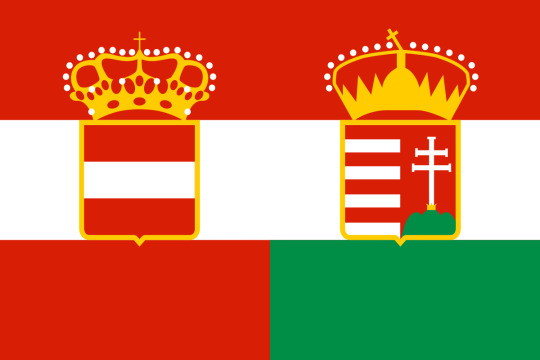

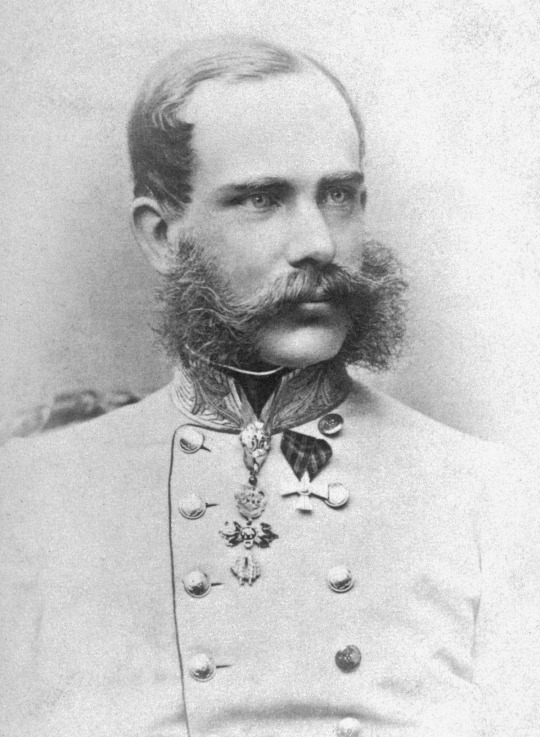

#19th century#compromise#european history#austria#hungary#Austrian Empire#austro-hungarian empire#austria-hungary#franz joseph#hapsburg#vienna#budapest
8 notes
·
View notes
Text
2nd Regnant Queen and 29th Monarch of Portugal (9th of the Bragança Dynasty): Queen Maria II of Portugal, “The Educator/The Good Mother”
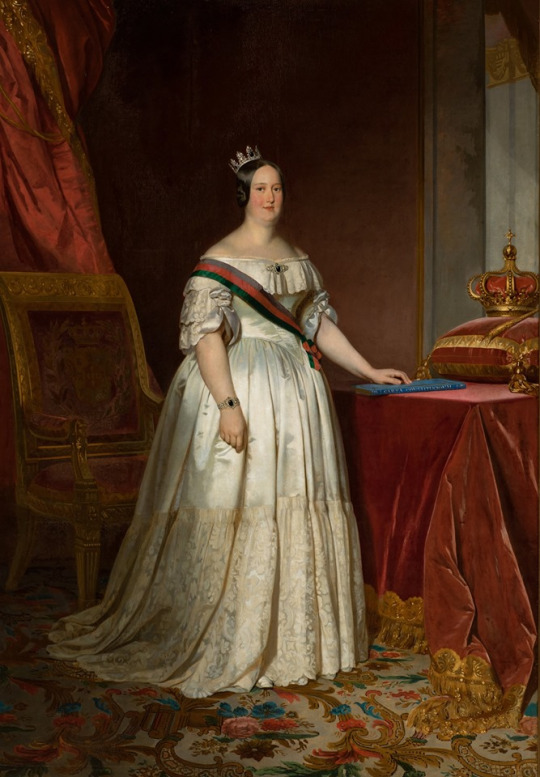
Reign: 26 May 1834 – 15 November 1853
Acclamation: 20 September 1834
Predecessor: Pedro IV
Maria II (4 April 1819 In Rio de Janeiro – 15 November 1853 in Lisbon) "the Educator" ("a Educadora") or "the Good Mother" ("a Boa Mãe"), reigned as Queen of Portugal from 1826 to 1828, and again from 1834 to 1853. Born in Rio de Janeiro, she was the first child of King Pedro IV of Portugal (Pedro I of Brazil) and his first wife, Queen Maria Leopoldina, and thus a member of the House of Bragança. One of the two surviving children born when Pedro was still heir apparent to Portugal, she inherited Portuguese titles and was placed in the line of succession to the former Portuguese throne, even after becoming a member of the Brazilian Imperial Family, from which she was excluded in 1835 after her definitive ascension to the Portuguese throne.

Maria II was born Maria da Glória Joana Carlota Leopoldina da Cruz Francisca Xavier de Paula Isidora Micaela Gabriela Rafaela Gonzaga on 4 April 1819 in the Palace of São Cristóvão
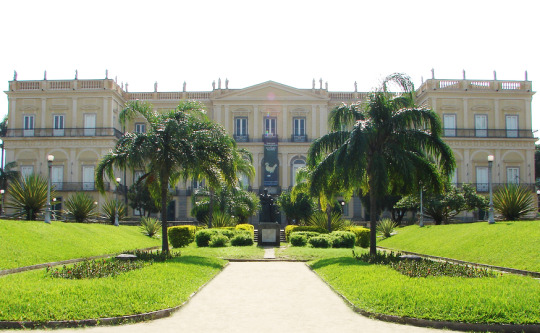
in Rio de Janeiro, Kingdom of Brazil. She was the eldest daughter of the Prince Pedro de Alcântara, future King of Portugal as Pedro IV and first Emperor of Brazil as Pedro I, and his first wife Maria Leopoldina (née Archduchess Caroline Josepha Leopoldine of Austria), herself a daughter of Francis II, Holy Roman Emperor. She was titled Princess of Beira upon her birth. Born in Brazil, Maria was the only European monarch to have been born outside of Europe, though she was still born in Portuguese territory.
The death of Maria's grandfather, King João VI, in March 1826 sparked a succession crisis in Portugal. The king had a male heir, Pedro,

but Pedro had proclaimed the independence of Brazil in 1822 with himself as Emperor. The late king also had a younger son, Miguel,
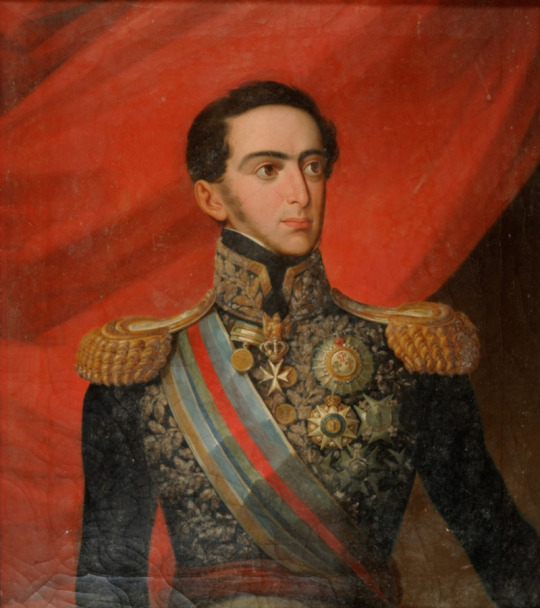
but he was exiled to Austria after leading a number of revolutions against his father and his liberal regime.
Before his death, the king had nominated his favourite daughter, Isabel Maria, to serve as regent until "the legitimate heir returned to the kingdom" — but he had failed to specify which of his sons was the legitimate heir: Pedro, the liberal Emperor of Brazil, or Miguel, the absolutist exiled prince.
Most people considered Pedro to be the legitimate heir, but Brazil did not want him to unite Portugal and Brazil's thrones again. Aware that his brother's supporters were ready to bring Miguel back and put him on the throne, Pedro decided for a more consensual option: he would renounce his claim to the Portuguese throne in favour of his daughter Maria (who was only seven years old), and that she was to marry her uncle Miguel, who would accept the liberal constitution and act as a regent until his niece reached majority.
Miguel pretended to accept, but upon his arrival in Portugal he immediately deposed Maria and proclaimed himself king, abrogating the liberal constitution in the process. During his reign of terror, Maria traveled to many European courts, including her maternal grandfather's in Vienna, as well as London and Paris.

Maria's first reign was interrupted by the absolutist uprising led by her uncle, fiancé and regent Miguel, who proclaimed himself King of Portugal on 23 June 1828. Then began the Liberal Wars that lasted until 1834, the year in which Maria was restored to the throne and Miguel exiled to Germany.
The Marquis of Barbacena,
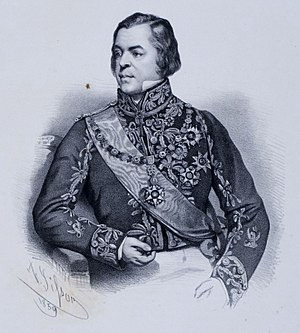
arriving in Gibraltar with the princess on 3 September 1828, was informed by an emissary of what was happening in Portugal. He had the foresight to understand that Miguel had come from Vienna determined to put himself at the head of the absolutist movement, advised by Prince Klemens von Metternich,

who was directing European politics, and so it was dangerous for the young Queen to go to Vienna. Taking responsibility, he changed the direction of the journey, and departed for London, where he arrived on 7 October. English policy was not conducive to its purpose. The Duke of Wellington's
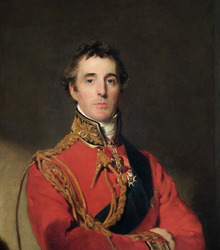
office openly sponsored Miguel, so the asylum the Marquis had sought was not safe. Maria II was received in court with the honors due to her high hierarchy, but the British prevented their subjects there emigres to go to reinforce the garrison of the island Terceira.
Miguel's coup d'état had not gone unrevealed. On 16 May 1828, the garrison of Porto revolted, and in Lagos an infantry battalion. The revolts were stifled. Saldanha, Palmela, and others, who had come to take charge of the movement in Porto, re-embarked on Belfast ship, which had brought them; the Porto garrison, reinforced by the academic volunteers of Coimbra and other liberal troops, emigrated to Galiza and from there to England. At the head of a small liberal expedition, the Marquis of Saldanha attempted to disembark in Terceira, Azores, but was not allowed to take the English cruise, whose vigilance he could not avoid for some time after the Count of Vila Flor, later of Terceira, was able to disembark. In time, because in August 1829 appeared in front of the island a huge Miguelist squad that sent to soil a body of disembarkation. Then there was the Battle of August 11 in the village of Praia, where the miguelists were defeated. When the emigrants in England received the news of the victory, they felt great enthusiasm. They soon lost hope of knowing that the young queen was returning to the Brazilian Empire to her father. In fact, the situation of Maria II in the English court, next to the ministry in the power, became embarrassing and humiliating. The Queen left London to meet her future stepmother, Amélie of Leuchtenberg.
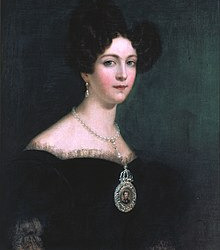
They left together on 30 August 1829 for Rio de Janeiro, arriving on 16 October.
The constitutional cause was thought to have been lost. The dispersed emigres (France, England and Brazil) were divided into rival factions. Only Terceira Island recognized the constitutional principles, and even there appeared miguelists guerillas. France was ready to recognize Miguel's government when the revolution of July broke out in Paris in 1830, which encouraged the Portuguese liberals.
In 7 April 1831, Pedro IV abdicated the imperial crown of Brazil on behalf of his son Pedro II,
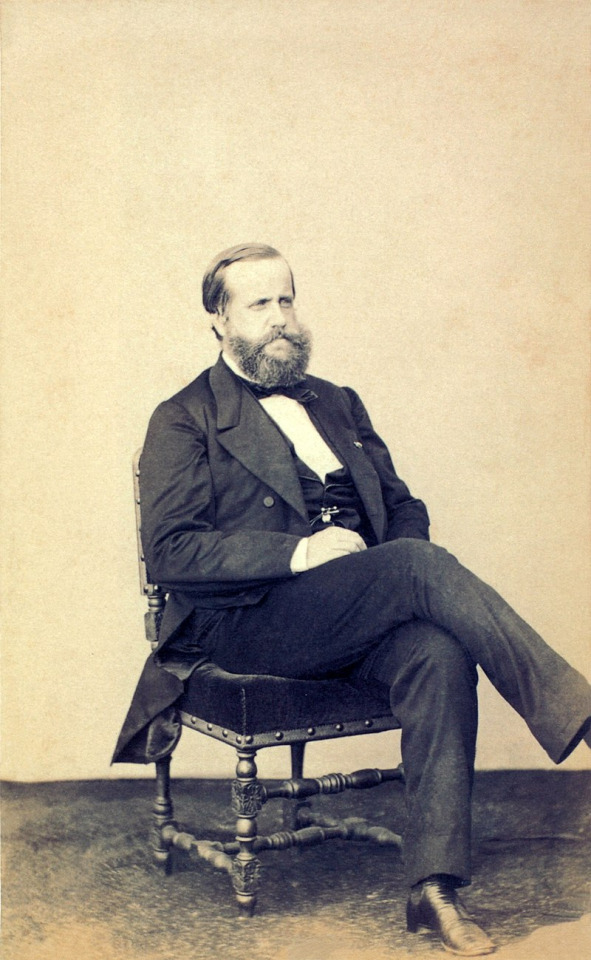
Maria's younger brother, and came to Europe with his daughter and his second wife, to support his daughter's rights to the crown from Portugal and joined the forces loyal to Maria in the Azores in their war against Miguel. He took the title of Duke of Bragança, and Regent in her name.
Almost at the same time the regency of the Ilha Terceira, named by Pedro and composed of the Marquis of Palmela, the Count of Vila Flor and José António Guerreiro, prepared an expedition that soon took possession of the Azores. While extending the constitutional territory, Pedro disembarked in France, being welcomed with sympathy by the new government and by Louis Philippe I.
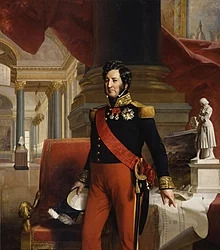
Miguel's government had defied the immunities of French subjects, had not at once satisfied the complaints of the French government, which had sent a squadron commanded by Admiral Roussin to force the bar of Lisbon and impose humiliating conditions of peace.
Pedro left his daughter in Paris to finish her education, delivered to her stepmother, Empress Amélie, with good masters, and left for the Azores at the head of an expedition organized on the island of Belle Isle, bringing his supporters together. Arriving in the Azores on 3 March 1832, he formed a new ministry, assembled a small army, whose command he gave to the Count of Vila Flor, and carried him aboard a squadron which he delivered to the English officer Sartorius, and departed for mainland Portugal. July 8 at Memória Beach in Matosinhos. It was followed by the Siege of Porto and a series of battles until, on 24 July 1833, the Duke of Terceira entered victorious in Lisbon, having won the Battle of Cova da Piedade the day before. Porto and Lisbon, the main cities, were in the power of the liberals. Pedro came to Lisbon, and summoned his daughter from Paris, forcing his brother, Miguel to abdicate in 1834. Maria was thereupon restored to the throne, and obtained an annulment of her betrothal. Soon after her restoration to the throne, her father died from tuberculosis.
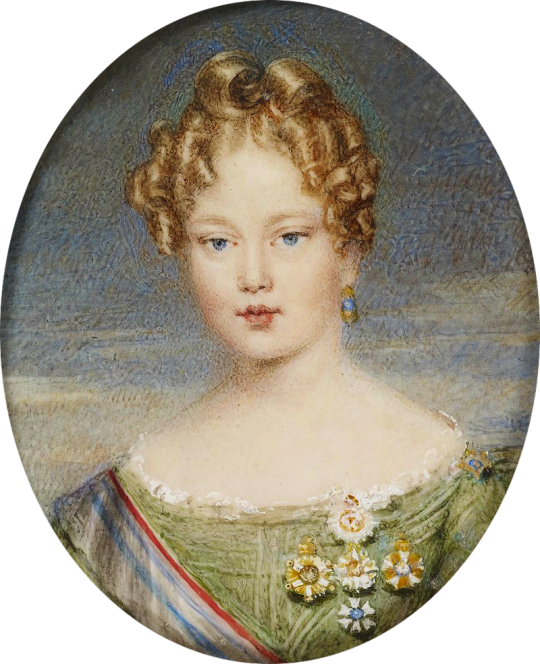
On 7 February 1833, in order to protect the Queen, the 2nd Lancers Regiment was created, first known as the Regimento de Lanceiros da Rainha (Queen's Lancers Regiment), with the motto Morte ou Glória, "Death or Glory" (the same as the 17th Lancers, since Lt. Col. Sir Anthony Bacon was its first commander), a fortunate coincidence since the queen's name was Maria da Glória.
Occupying the Portuguese throne, Maria II was still heir presumptive to her brother Pedro II as Princess Imperial of Brazil, until her exclusion from the Brazilian line of succession by law no. 91 of 30 October 1835.

Maria married Auguste, Duke of Leuchtenberg,
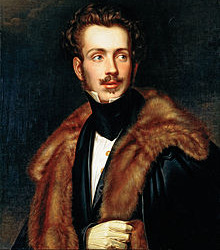
son of Eugène de Beauharnais
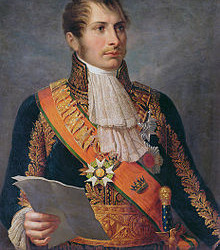
and grandson of the Empress Josephine of France,

on 26 January 1835, at the age of fifteen. However, he died only two months later, on 28 March 1835.
On 9 April 1836, she married the cultured and able Prince Ferdinand of Saxe-Coburg and Gotha. In accordance with Portuguese law, Ferdinand received the title of king upon the birth of their first child and heir, Pedro.
In 1842, Pope Gregory XVI

presented Maria with a Golden Rose.

Maria's reign saw a revolutionary insurrection on 16 May 1846, but this was crushed by royalist troops on 22 February 1847, and Portugal otherwise avoided the European Revolution of 1848. Maria's reign was also notable for a public health act aimed at curbing the spread of cholera throughout the country. She also pursued policies aimed at raising the levels of education throughout the country.
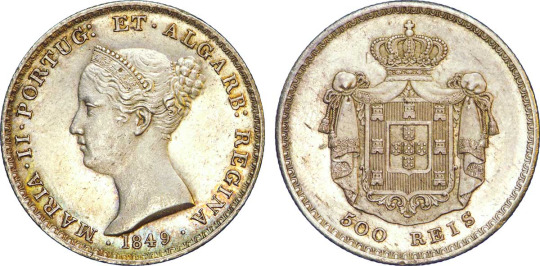
From her first pregnancy, at the age of eighteen, Maria II faced problems in giving birth, with prolonged and extremely difficult labor. An example of this was her third gestation, whose labor lasted 32 hours, after which a girl was baptized in articulo mortis with the name of Maria (1840).
At 25 years of age and in her fifth gestation, the sovereign became obese and her births became even more complicated. In 1847, the fetal distress that preceded the birth of her eighth child – the Infante Augusto, Duke of Coimbra – brought to the world a child "quite purple and with little breathing".
The dangerous routine of successive pregnancies, coupled with obesity (which eventually caused her heart problems) and the frequency of dystocic births (worrisome, especially as a multiparous woman) led doctors to warn the queen about the serious risks she would face in future pregnancies. Indifferent to the warnings, Maria II merely replied: "If I die, I die at my post."

On 15 November 1853, thirteen hours after the onset of labor of the stillborn infant Eugenio, her eleventh child, Maria II died at the age of 34. The announcement of death was published in the Government Gazette of November 16, 1853:
“Paço das Necessidades, November 15, 1853, at half an hour after noon.
Her Majesty the Queen began to notice announcements of childbirth at nine-thirty on the night of the day. Difficulties appeared in the progress of the same childbirth, which forced the doctors to resort to operations, for which the extraction of an infant was obtained, of time, which received the baptism before being extracted.
The result of these operations took place at ten o'clock in the morning. Unfortunately, after an hour and a half, Her Majesty, exhausted from all strength, declared "I surrender my soul to God after having received all the sacraments."
In a letter dated November 28, 1853, the Duchess of Ficalho, the queen's maid, reported the outcome to her brother, the 2nd Earl of Lavradio:
“At two o'clock after midnight from the 14th to the 15th, I was ordered to go to the Palace, where I arrived at about three o'clock. I found the Empress in the Queen's room, where I immediately entered, thinking Her Majesty troubled and even little then we left the immediate room and asked Teixeira what he thought, telling us: "Your Majesty is going well, but slowly." I did not like it, and it was like that, until Teixeira called the doctors, who were out and who had not seen the Queen, and as soon as they examined her, the horrible operation was decided: the doctors were Teixeira, Farto, Kessler, Elias and Benevides. Kessler immediately dismissed the case as very dangerous. The operation was begun. I climbed onto the bed. On the right side, the Empress, full of tears; the Queen, with no fainting, but with a very bad opinion, and, complaining that she was suffering enough, said in her natural voice: "O Teixeira, if I am in danger, tell me, do not deceive me."
Queen Maria II is remembered as a good mother and a kind person who always acted according to her convictions in her attempt to help her country. She was later given the nickname "The Good Mother."

She was buried in the Bragança Pantheon,in Monastery of São Vicente de Fora. :

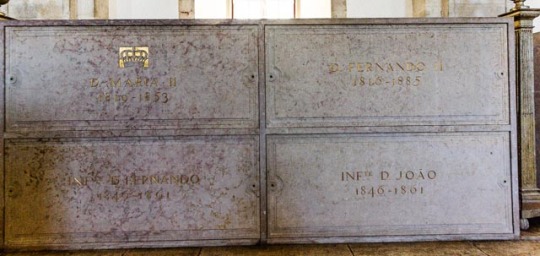
Maria first married Auguste Charles, 2nd Duke of Leuchtenberg, son of Eugène de Beauharnais, grandson of Empress Josephine, who died soon after arriving in Portugal. She then married Ferdinand of Saxe-Coburg and Gotha, son of Prince Ferdinand Georg August of Saxe-Coburg and Gotha and his wife Princess Maria Antonia Koháry de Csábrág.
Pedro (16 Setember 1837 - 11 November 1861) Succeeded his mother as Pedro V, King of Portugal.
Luís (31 October 183819 October 1889) Succeeded his brother, Pedro, as King of Portugal.
Infanta Maria (4 October 1840) Stillborn daughter.
Infante João (16 March 1842 - 27 December 1861) Duke of Beja
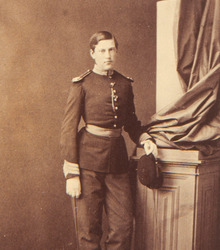
Infanta Maria Ana (21 August 1843 - 5 February 1884) Married King George of Saxony and was the mother of King Frederick August III of Saxony.
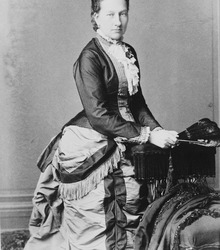
Infanta Antónia (17 February 1845 - 27 December 1913) Married Leopold, Prince of Hohenzollern, and was the mother of King Ferdinand I of Romania.

Infante Fernando of Portugal (23 July 1846 - 6 November 1861) Died of cholera at age 15.
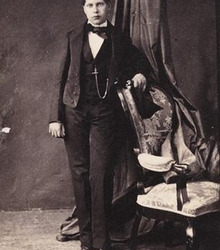
Infante Augusto (4 November 1847 - 26 September 1889) Duke of Coimbra

Infante Leopoldo (7 May 1849) Stillborn son.
Infanta Maria da Glória (3 February 1851) Stillborn daughter
Infante Eugénio (15 November 1853) Died some hours after the death of his mother.
10 notes
·
View notes